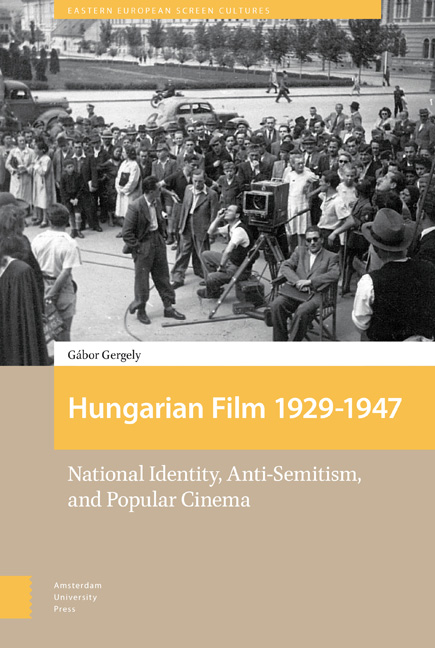Book contents
- Frontmatter
- Dedication
- Contents
- List of Illustrations
- Acknowledgements
- A Note on Accents, Pronunciation, Names, and Spellings
- Preface
- Introduction
- 1 Key Concepts in Pre-1945 Hungarian Cinema
- 2 A Contested Film History
- 3 An Industry Emerges 1931-1935
- 4 Boom, Crisis and Anti-Semitic Reorganization 1936-1941
- 5 From War Boom to Bust 1941-1944
- Epilogue: Industry Reboot and the Myth of a New Start 1945-1947
- Concluding Remarks
- Bibliography
- Index
- Frontmatter
- Dedication
- Contents
- List of Illustrations
- Acknowledgements
- A Note on Accents, Pronunciation, Names, and Spellings
- Preface
- Introduction
- 1 Key Concepts in Pre-1945 Hungarian Cinema
- 2 A Contested Film History
- 3 An Industry Emerges 1931-1935
- 4 Boom, Crisis and Anti-Semitic Reorganization 1936-1941
- 5 From War Boom to Bust 1941-1944
- Epilogue: Industry Reboot and the Myth of a New Start 1945-1947
- Concluding Remarks
- Bibliography
- Index
Summary
The received view of Hungarian filmmaking in the period this book takes as its focus is that a Jewish-dominated profession was fundamentally transformed by anti-Jewish laws, yet certain Jewish scriptwriters continued to supply scripts for the new, putatively racially pure Hungarian film industry up to as late as the German occupation in March 1944. In this received view of the period the war was followed by another fundamental transformation during the denazification of the industry. Certain names are associated with the era: comedian Gyula Kabos and the commanding Gyula Csortos, romantic lead Pál Jávor and his frequent co-star Katalin Karády, the director István Székely and right-wing filmmaker Viktor Bánky and his favoured star Antal Páger, and the actor and Communist dissenter Zoltán Várkonyi. This list reflects the received view: split into Jewish filmmaking (Kabos and Székely), right-wing filmmaking (Bánky and Páger), Communist, opposition filmmaking (Várkonyi), and what is in between, a kind of apolitical tradition of ‘Hungarian’ filmmaking typified by Jávor and Karády.
This view is not merely a simplified view of the era, but a crucially distorted and misleading interpretation that is the product of the twin legacies of anti-Semitism and Communist era film scholarship. First, the idea that there was a clear dividing line between the ‘Jewish industry’ of the period leading up to 1938 and the ‘racially pure’ film sector of 1938-1944 is anti-Semitic nonsense. The industry of the 1930s was not inherently Jewish, although that is precisely what many scholars claim (e.g. Manchin 2012a; 2013). Instead, Jewish Hungarians participated in filmmaking alongside Christian and atheist Hungarians, and other colleagues from a variety of national, ethnic, and religious backgrounds. Plurality existed, albeit in a limited form. The limitations came from state oversight of the industry, which, as we shall see, should be dated to 1920 and the introduction of cinema operator licences. It follows that the post-1938 era differed from the period that preceded it in terms of the level of state control rather than in religious and/or ethnic terms.
The second claim that the postwar vetting of the industry was transformative is plain Communist propaganda. Look no further than Zoltán Várkonyi, a leading figure in the postwar film establishment who played a key role in the vetting committees.
- Type
- Chapter
- Information
- Hungarian Film, 1929–1947National Identity, Anti-Semitism and Popular Cinema, pp. 17 - 48Publisher: Amsterdam University PressPrint publication year: 2017



